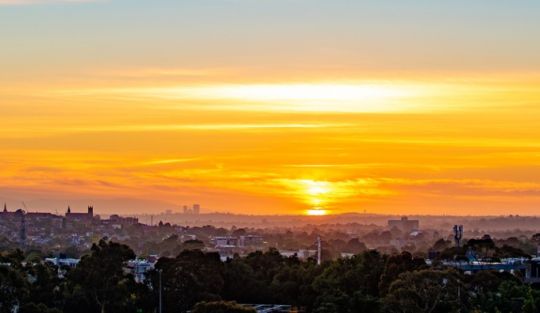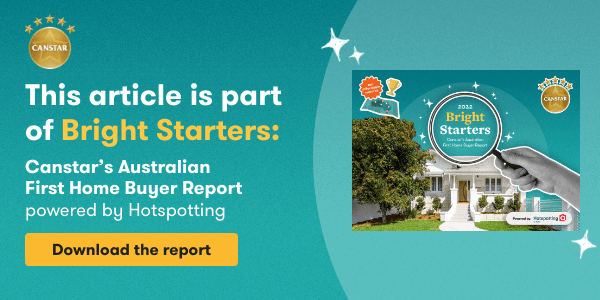The 10 best suburbs in Melbourne for first home buyers
Find out which suburbs in Melbourne made the top 10 Rising Stars in the Canstar Australian First Home Buyer Report 2024, powered by Hotspotting.

Find out which suburbs in Melbourne made the top 10 Rising Stars in the Canstar Australian First Home Buyer Report 2024, powered by Hotspotting.
Melbourne is the big improver in the national real estate scene in 2024. Its national ranking has jumped from 13th in the 2023 edition of Rising Stars to equal fifth (alongside Regional Queensland) in this report.
Very little separates the top five in this analysis, so Melbourne rates only marginally behind Brisbane, Sydney, Adelaide and Perth in our assessment of prospects for 2024. The transformation of the Melbourne market in the second half of 2023 is one of the year’s big real estate stories. It started 2023 as a struggling market, with sales activity weak and prices falling. Market activity improved dramatically as the year evolved, but has not yet translated into major price rises – so there is potential for good growth in 2024. One of the core factors in the Melbourne revival was the improvement in the Victorian economy, ranked by CommSec as the nation’s strongest in the October 2023 edition of the State of the States report.
Of course, price isn’t the only consideration for first home buyers. A good lifestyle and prospects for growth should also be on the checklist. In Canstar’s Bright Stars Australian First Home Buyer Report for 2024, we used five key metrics – sales volumes, price growth, vacancy rates, infrastructure and proximity to work and amenities – to identify suburbs that are desirable and likely to grow in value over time. Check out our list below.
The 10 best suburbs in Melbourne for first home buyers
- Ascot Vale
- Boronia
- Brunswick East
- Collingwood
- Frankston
- Mill Park
- Mitcham
- Northcote
- Nunawading
- Oakleigh
Ascot Vale
Homes are selling quickly in this suburb just 6 km north-west of the Melbourne CBD, with a median house price now above $1.3 million and apartments becoming popular around $600,000. The suburb is connected via both trains and trams, as well as Citylink. It is also a neighbour of Parkville with its hospitals and university campuses. Vacancies are below the Melbourne average at 1%.
Boronia
The key statistics show how popular this eastern suburb of Melbourne is becoming, with 226 house sales and 205 apartment sales in the past 12 months. Homes typically sell inside three weeks and the vacancy rate below average for Melbourne at 0.7%. Its commercial-retail hub has two shopping centres and a train station linking it to central Melbourne. There are numerous schools in the suburb, including four primary schools.
Brunswick East
The three Brunswick suburbs (North, East and West) attract plenty of demand with their proximity to hospitals, universities, Melbourne Zoo and the Melbourne CBD. The median house price for Brunswick East is $1.3 million, but apartments are in the $500,000s and outnumber house sales three to one. Both dwelling types typically sell within three to four weeks and the vacancy rate is below average for Melbourne at 0.7%.
Collingwood
The rise of inner-city Melbourne markets includes the City of Yarra, with one of its suburbs, Collingwood, attracting increasing demand for its relative affordability, connectivity and proximity to the Melbourne CBD. Both houses and apartments generally sell within three weeks, and apartment sales outnumber houses four to one. The low vacancy rate of 0.6% provides further evidence of the suburb’s popularity. Local features include a TAFE campus and major green spaces along the Yarra River.
Frankston
The bayside suburb of Frankston, in the far south of Greater Melbourne, has grown in popularity for its affordability, infrastructure and good transport links. In the past 12 months, over 800 houses and units have been purchased, with median prices of $720,000 and $485,000, respectively. Homes generally sell in three to four weeks, and the vacancy rate is just 0.8%. Schools, universities, hospitals and golf courses are part of the Frankston offering.
Mill Park
The Whittlesea Local Government Authority (LGA) is one of Greater Melbourne’s growth areas, with new suburbs being added as the city spreads north. Mill Park is one of the longer established suburbs and recorded over 320 dwelling sales in the past 12 months. The 0.5% vacancy rate is one of the lowest in Greater Melbourne. The suburb includes the Westfield Plenty Valley complex and has two neighbours with major facilities – Epping and Bundoora.
Mitcham
The City of Whitehorse is consistently one of the leading markets in Middle Melbourne, and Mitcham is one of several popular residential suburbs. Buyer demand is rising, with over 250 dwelling sales in the past year. Homes typically sell in three to four weeks and vacancies are low at 0.7%. Mitcham is a place of many parks and schools, with quick access to the M3 Eastern Freeway.
Northcote
This inner northern suburb has grown in popularity for its local character and proximity to central Melbourne, with 375 dwelling sales in the past year and vacancies ultra low at 0.5%. The house median is above $1.6 million, and apartments provide a significantly cheaper alternative in the $600,000s. Shopping centres Northcote Plaza and Northcote Central sit alongside All Nations Park.
Nunawading
This is a suburb for families seeking relatively affordable homes and schools; as well as major large item retail stores. It also boasts rail links to inner Melbourne. It’s also ethnically diverse, with 40% of residents born outside Australia. Buyer demand has increased in recent times and homes typically sell in three to four weeks, with a vacancy rate under 1%.
Oakleigh
The City of Monash is one of the economic strongholds of Greater Melbourne, with Monash University, Monash Medical Centre and the Victorian Heart Hospital, among other facilities. Oakleigh is one of the LGA’s sought-after residential suburbs, with major road and rail links to central Melbourne.This area also has multiple golf courses. The median house price is above $1.3 million and apartments (in the $500,000s) are becoming increasingly popular.
The best suburbs in Melbourne for first home buyers
← Mobile/tablet users, scroll sideways to view full table →
| Suburb | Median price | 1-yr growth | 10-yr average annual growth (%pa) | Vacancy rate | Median rental yield | Initial Outlay (no concessions) on 20% deposit |
Monthly repayments |
|---|---|---|---|---|---|---|---|
| Ascot Vale | $1,325,000 | 0.4% | 2.6% | 1.0% | 2.6% | $341,190 | $6,700 |
| Ascot Vale (Unit) | $595,000 | 2.8% | 3.5% | 1.0% | 4.5% | $151, 377 | $3,009 |
| Boronia | $840,000 | -0.6% | 3.1% | 0.7% | 3.3% | $215,651 | $4,247 |
| Boronia (Unit) | $645,000 | -0.7% | 2.6% | 0.7% | 4.0% | $164,494 | $3,261 |
| Brunswick East | $1,300,000 | -3.6% | 4.7% | 0.7% | 2.8% | $334,757 | $6,574 |
| Brunswick East (Unit) | $565,000 | -5.4% | 2.1% | 0.7% | 4.8% | $161,871 | $2,857 |
| Collingwood | $1,240,000 | -7.2% | 3.1% | 0.6% | 2.8% | $319,317 | $6,270 |
| Collingwood (Unit) | $635,000 | -8.7% | 1.5% | 0.6% | 1.2% | $161,871 | $3,211 |
| Frankston | $720,000 | -7.7% | 3.6% | 0.8% | 3.7% | $184,170 | $3,641 |
| Frankston (Unit) | $485,000 | -12.1% | 2.2% | 0.8% | 4.5% | $119,420 | $2,452 |
| Mill Park | $765,000 | -1.9% | 3.2% | 0.5% | 3.2% | $195,975 | $3,868 |
| Mill Park (Unit) | $490,000 | -3.5% | 1.1% | 0.5% | 4.6% | $120,732 | $2,478 |
| Mitcham | $1,200,000 | 0.8% | 3.9% | 0.7% | 2.5% | $309,023 | $6,068 |
| Mitcham (Unit) | $810,000 | -1.1% | 5.0% | 0.7% | 3.6% | $207,780 | $4,096 |
| Northcote | $1,665,000 | -2.1% | 4.6% | 0.5% | 2.6% | $428,301 | $8,419 |
| Northcote (Unit) | $625,000 | -3.3% | 3.7% | 0.5% | 4.3% | $159,247 | $3,160 |
| Nunawading | $1,190,000 | 0.8% | 3.7% | 0.8% | 2.5% | $306,450 | $6,017 |
| Nunawading (Unit) | $825,000 | -0.5% | 6.2% | 0.8% | 3.5% | $211,715 | $4,172 |
| Oakleigh | $1,350,000 | -6.5% | 3.0% | 1.2% | 2.5% | $347,624 | $6,826 |
| Oakleigh (Unit) | $545,000 | -9.4% | -0.7% | 1.2% | 4.3% | $135,160 | $2,756 |
Source: www.canstar.com.au. Prepared on 22/01/2024. Based on a selection of suburbs’ median prices, growth and rent figures provided by Hotspotting by Ryder. Initial outlay figures include the deposit, stamp duty, mortgage registration and transfer fees; and lenders’ mortgage insurance (LMI) premium for the 10% deposit scenarios. Stamp duty calculated based on an owner occupier purchase of an established dwelling. LMI premium based on Helia LMI Premium Calculator for an owner occupier borrower and a loan term of 30 years. Monthly repayments calculated based on the average variable interest rates of 6.5% (20% deposit) and 6.8% (10% deposit) and a loan term of 30 years. Interest rates based on the average owner occupier, principal and interest variable rate for a loan of $600,000 over the past year, rounded to the nearest 0.1%. Percentage of income based on the average total income by Greater Capital City Statistical Area (ABS Personal Income, 2020-21), adjusted by the ABS Wage Price Index (Sep-2023) for each state.
This article was reviewed by our Editor-in-Chief Nina Rinella before it was updated, as part of our fact-checking process.

The comparison rate for all home loans and loans secured against real property are based on secured credit of $150,000 and a term of 25 years.
^WARNING: This comparison rate is true only for the examples given and may not include all fees and charges. Different terms, fees or other loan amounts might result in a different comparison rate.
 Owner occupied
Owner occupied
 20% min deposit
20% min deposit
 Redraw facility
Redraw facility
Try our Home Loans comparison tool to instantly compare Canstar expert rated options.






